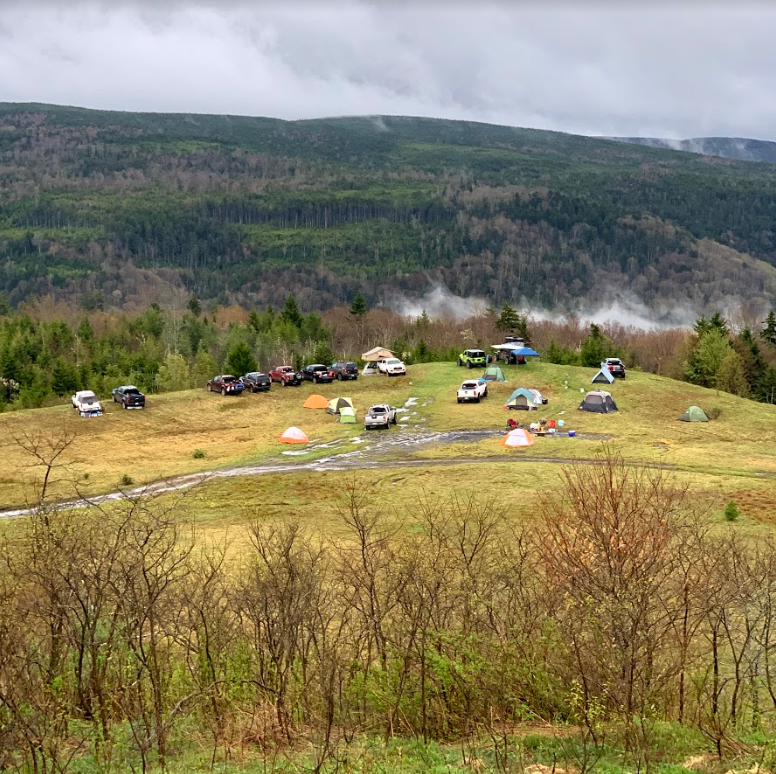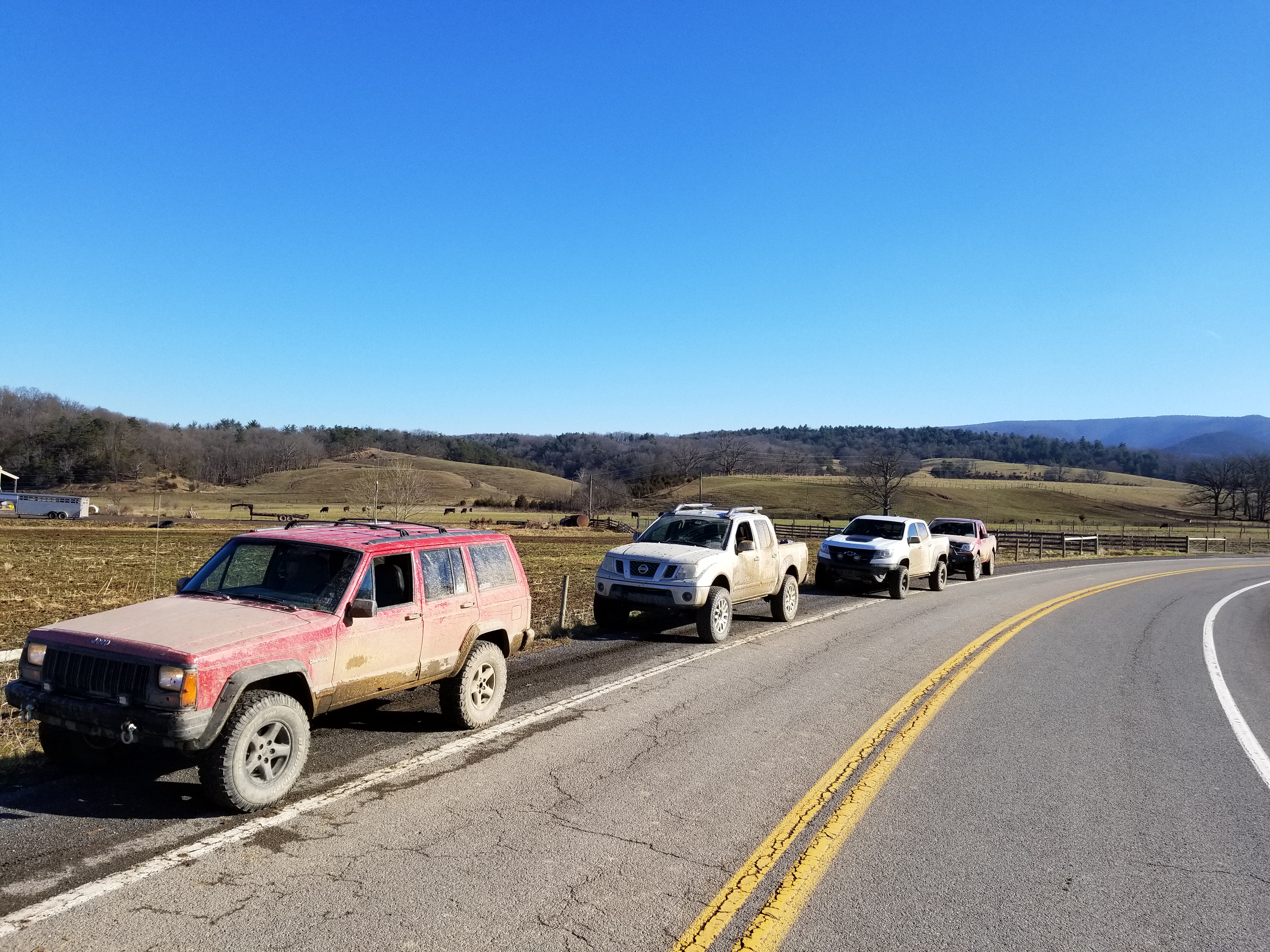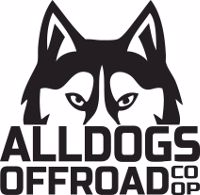Hey guys! We asked one of the members of our cooperative to write up a guide on organizing group rides. His name is Nick Cornell and he helps lead the CAMO group which is located on the east coast. He's super rad, and this is what he wrote!
Spam, Beans, and 4x4s

Its glamorous really, the foliage has changed to a crisp auburn and fiery orange as a cool breeze blows through your cracked window. A steaming Columbian roasted coffee sloshing around in a fresh Yeti tumbler. A convoy of clean modern 4x4s walk over obstacles through the tree lines as a perfectly placed drone captures the best aerial footage. Long time friends together, headed to the perfect pre-planned camp location, soon to set up a large contained camp fire while drinking smelly IPAs and telling stories. Perfection. The night sky is so clear you can see the mil……….*THWACK* WAKE UP!
My name is Nick Cornell, I run Central Appalachian Mountain Overland with three close friends, Camden Nichols, Nick Palko, and Steve Vilbert. Central Appalachian Mountain Overland (CAMO) was something that just kind of happened. My group of friends was always interested in motorsports. We started off like any 16-19-year olds: With Riced out econo-boxes and Subarus. We didn’t really think it at the time, but looking back, it’s pretty comical. As we got older the cars went away and the 4x4s became the new flavor. I actually didn’t get rid of my riced out race red Ford Focus by choice, unfortunately, she met her demise by means of a 10 point buck. I purchased a 2012 Nissan Frontier. I think I still have the text messages that I sent to my friends shortly after bringing it home. Something to the tune of, “I’m leaving this one stock. Can’t believe how much money I wasted on that car.” ….Sure. Good plan.
Our very first trip was about as comical as an “overland” trip can be. I was in a bone stock Nissan Frontier, Camden was in a Red Cherokee from the thunder dome, Brennan was driving a full size short bed single cab F-150 from back when you were still dating cheerleaders, and Palko was in a brand new, sticker still on the back glass - Chevy ZR2 Colorado. I hastily downloaded a GPX file of a well known dual sport motorcycle route and we set off for West Virginia. I didn’t disseminate the maps to any of my friends and didn’t really even explain what we were doing and where we were going.

We pounded pavement into Dry-Fork West Virginia after a brief holdup to add some diff fluid and friction modifier to the Ford. I came over the CB (I think we had CBs for this trip) and said, “Hey guys, we turn right in a couple hundred feet.” A few seconds later, my eyes caught the trail and I jacked the brakes and dropped down about fifteen feet directly into the Dryfork River. (This was part of the trail) Now, it had been raining heavily in the preceding weeks and the river was high; however, this is a one way, my stock Frontier wasn’t turning around and I surely wasn’t backing up what I had just gone down. I clicked it into 4-Hi and gave it the beans out of pure fear and ignorance. Smashing and banging along the bottom of the river, the water began to creep deeper and deeper. I looked out the driver’s window to watch cool West Virginian River water splash up to my headlights. Full Pucker. Finally, 100 yards later, I was on dry land and the truck didn’t drown. One by one we all made it across and celebrated this small victory with a trailside beverage.
As the sun started to set and our stomachs started to crave camp food and luke warm, shaken beers. We decided it was time to find a camp spot. Well, suffice to say, the dead center of the George Washington National Forest doesn’t necessarily have a surplus of clearings. Finally, we came across a great spot, got a fire going, set up our tents, and started one of the best parts of the trip.
The following morning, we set off and continued East in the GWNF. *THWUB THWUB SCHREEECH THWUB THWUB* The Ford tossed a belt. “Tossed” is probably the wrong word. It was more like a fibrous explosion. No matter, Brennan had a spare. Sort of. The spare was his older belt that was in decent condition but it was sized just slightly off. Brennan deleted his AC so the stock belt size was incorrect. His off the shelf belt was working but slightly undersized. As we continued on, Brennan noticed his belt had come off once again. Upon inspection, we found that there were only 3 strands of belt surviving. Something was causing the belt to get tossed into a bracket near the water pump. Yikes. We were near Snowshoe WV at the time. I remembered that I had Gorilla tape in the truck. We tediously recreated a belt from the Gorilla tape as a Hail Mary attempt at getting us 40 miles North to Elkins to fix the truck and get home. Miraculously, the Gorilla tape held and we were able to fix the truck and return safely home to Pennsylvania.
At this point we were hooked. I learned a lot of valuable information from that trip and all of our trips to follow. Arranging an offroad trip or managing a club is a lot of work. Below are a few tips that will help you arrange an offroad outing or partake in one:
1. Bust out the paper maps
- When planning a route find a paper map source that fits the area that you wish to travel. Physically trace the route in a sharpie marker. Along the way, circle locations of parts stores, gas stations, beer distributors, and potential camp spots as well as any other points of interest. I love “Purple Lizard Maps.”
2. You’re the captain now
- Let’s face it, you’ve done all of the leg work, you sent out the gpx. files to you crew, encouraged everyone to download it, and alas, you’re the only guy with the route. Relax. Everyone is just happy they’re not at work. You can alleviate the pressure on yourself with a good co-pilot or a good heads up display of your track. I really like GAIA GPS. I paid for the pro version and purchased a 60 dollar tablet that has GPS capabilities from Amazon. *IMPORTANT* Download the base layers of the maps to your tablet. Cram the biggest card in that thing that you can and achieve the best granularity possible. This way, even without service, you can watch yourself follow your perfectly plotted path.
3. Can you hear me now?
- Coms, Coms, Coms. This is always a topic of discussion and debate. Regardless of what you choose, it’s imperative that everyone in your group understands how important maintaining communications is. In our experiences, the trusty 2-way radio is the answer for a few reasons:
a. No one can mess it up
b. No installation
c. They cost 20 bucks
d. You can walk away from the vehicle and still maintain coms
e. Your spotter can hold his radio and guide you via radio
4. Are ya’ made of spare parts, bud?
- Bring spares of common failure parts. Belts, U-Joints, a headlight bulb, and anything specific to your rig that could be hard to find if you needed it. You will want to have an adequate tookit as well. A cordless impact gun can make a trailside repair go much, much smoother.
5. The Shepherd
- It’s nerdy but important: You need to have a brief driver meeting before you roll out. One of the most important trail rules to follow is that if you lose sight of the guy/gal behind you, you stop until you see them. This keeps everyone together. Make this well known before you head out.
6. “That Guy”
- There will always be one. He/she doesn’t listen, they don’t want spotters, they tear stuff up, they drive recklessly, etc. Get rid of that guy. While it’s awesome to have as many people as possible, its more awesome to not worry about “that guy.”
7. "WHO ARE YOU PEOPLE”
- You’re probably wondering how you get people interested in going with you. Well. I’m wondering the same thing. You’re going to find that there are a LOT of people who just simply build vehicles with no intent to use them. Seemingly endless folks “can’t get permission from their significant other,” and “ah dang, I’ve got the kid this week and also every week that you guys go out,” and “Dang next time dog.” Don’t sweat it. People flake, it is what it is. CAMO has been fortunate enough to have a solid 10 members who are die hard.
Social media is the best advertisement. There are some groups who do it far, FAR more than we do. These are the types of groups that admittedly, I steered away from. Some of these groups charge money. I just ethically can’t do that. I don’t own these lands and don’t expect anything in return for leading groups through them.
8. How many is too many?
- This is a weighted question. If the route is wide open, few obstacles, and you have a lot of camping options, you can ride 20+ without issue. If its tight and slow moving with a lot of obstacles, you’ll probably want to consider limiting it to 10-15 trucks.
9. MY LEG!
- Oh yeah, by the way, if someone gets hurt, they’re probably going to look at you, fearless leader. I encourage everyone have a medical kit specific to their needs in their vehicle. I also strongly request that all members coming on a sanctioned trip send me a message disclosing any personal medical conditions. I personally am a safety professional by trade and train in emergency response, first aid, and emergency extraction. My wife is also an RN. Many of our members are servicemen as well which helps tremendously should something happen. Don’t just buy bandaids and throw an EMT sticker on your truck, and don’t pretend to be competent if you’re not. Bare bones minimum, you need to **TRAIN** on the use of a tourniquet, carry hemostatic bandages, and have an assortment of gauzes and bandages/tapes, etc. I personally also carry a suture kit but there’s an extremely small chance that I’d ever deploy it.
10. Establish rules
- It’s difficult to be a stickler when all you want to do is have fun. Most of your rules are going to be common sense. Make sure you stick to them and offer no exceptions. Enforcement is a team effort within your group.
11. Where am I supposed to sleep?
- There are innumerable variables that can and will arise when on the trail. Part of your pre-planning needs to be Primary, Secondary, Tertiary, etc camp locations. No one wants to wheel deep into the night. (except that one time, but that’s a tale for another day)
12. Let it go, Let it GOOOOOOO
- Its not going to go perfectly. Usually, that’s where the stories come from. Someone is going to break, get lost, roads closed, gates locked, whatever. Brush it off. You’re out doing what you love with people who are happy to be there with you. Roll with those punches and don’t be afraid to consult your crew for their ideas on the next best move.
If you’re interested in following our adventures, our Instagram handle is @cam_overland and our facebook group is Central Appalachian Mountain Overland.
Keep it rubber side down.
- Nick Cornell
.png)
